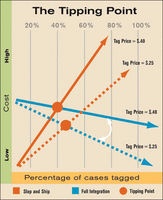Jul 20, 2004By Anthony Higginbottom
To meet deadlines for putting RFID tags on pallets and cases shipped to major retailers, manufacturers have to decide whether to start with a minimalist “slap-and-ship” approach or initiate a full-scale integration. Slapping tags on products just before they leave the manufacturing facility or warehouse could cost $2 million to $20 million annually, according to Forrester Research. Integrating RFID with back-end systems is much costlier.
So when should a company simply slap and ship? And when should it opt for a full-scale RFID integration?
Each company needs to do a business-case analysis to determine the best approach to achieving RFID compliance. But here are some things to consider. Slap and ship is a short-term stopgap approach that can be used only with small volumes of product. A full-scale implementation is a long-term, strategic option that involves deploying RFID enterprise-wide. The initial costs and effort required are much higher, but so is the potential return on investment.
The key to mitigating risk in RFID planning is to transition from a short-term, tactical approach to a long-term strategic one. When is the right time to begin making that incremental transition? To know that, a company has to determine its “tipping point.”
The tipping point is determined by analyzing when the financial benefits of a full-scale integration outweigh the cost of using a slap-and-ship approach. In other words, when you can save more by integrating RFID with the back end than it’s costing you to slap and ship, you’ve reached the tipping point.
The tipping point is different for each company. Producers of high-value products (such as film, batteries, razors or prescription drugs) that are often stolen or out of stock might gain significant benefits from a full-scale RFID deployment. So might companies that make high-value goods that are often counterfeited or become obsolete quickly.
The tipping point is constantly changing and is affected by many factors. If more retailers require RFID tagging, or more of a supplier’s facilities must install equipment to meet mandates, that drives up costs and brings the tipping point closer. If tag prices drop, that reduces costs and pushes the tipping point farther out (see chart). And if a company changes its product portfolio—say, it introduces a hot, high-value item—that might increase the potential benefits and alter the tipping point.
Companies that haven’t already launched a strategic RFID integration should conduct a tipping-point analysis. Slap and ship might be an effective starting point for some companies. But keep in mind that the tipping point is constantly changing, as tag prices and other costs and benefits change.
Planning a successful transition from a slap-and-ship approach to a full-scale implementation based on a tipping-point analysis could be the key to a successful, cost-effective RFID implementation. Start planning your transformational approach beyond slap and ship today—you may discover that you’ve already reached your tipping point.
Anthony Higginbottom is a senior manager in the multidisciplinary RFID practice of Deloitte, a New York–based consulting firm.

